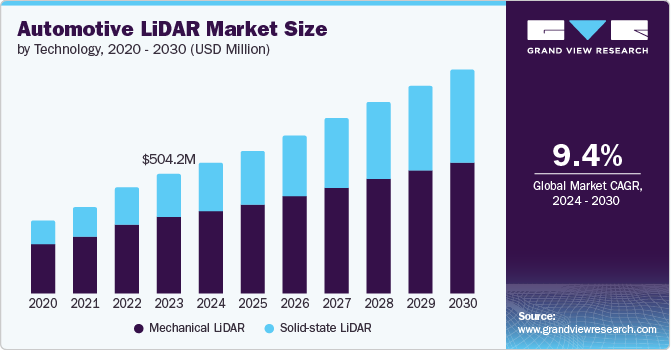The global automotive LiDAR market was valued at approximately USD 504.2 million in 2023, and it is projected to grow at a compound annual growth rate (CAGR) of 9.4% from 2024 to 2030. Several factors are driving this market, including the increasing adoption of autonomous vehicles and Advanced Driver Assistance Systems (ADAS), stricter safety regulations, technological advancements, and a rising consumer demand for improved driving experiences.
A key driver of the automotive LiDAR market is the growing use of autonomous and semi-autonomous vehicle technologies. LiDAR sensors play a critical role in accurately perceiving and mapping the vehicle's surroundings, which is essential for enabling autonomous driving capabilities. Additionally, there is an increasing emphasis on vehicle safety, coupled with government regulations that mandate the integration of advanced driver assistance systems. These factors are collectively fostering a heightened demand for automotive LiDAR systems.
Another noteworthy trend is the significant rise in the prominence of solid-state LiDAR solutions. These systems are more compact, cost-effective, and reliable compared to traditional mechanical LiDAR systems. This shift towards solid-state technology is largely driven by the need for scalable and integrated LiDAR solutions suitable for mass-market adoption. Moreover, the integration of LiDAR with other sensing technologies, such as cameras and radar systems, is becoming increasingly common. This sensor fusion enhances the overall perception capabilities and reliability of both ADAS and autonomous driving systems.
Gather more insights about the market drivers, restrains and growth of the Automotive Lidar Market
Application Insights
In 2023, the ADAS segment held the largest share of the global automotive LiDAR market revenue. The growing consumer focus on vehicle safety is a significant factor influencing this segment. As awareness of road safety issues increases, consumers are actively seeking vehicles equipped with advanced safety features. This shift in consumer preferences is prompting automakers to prioritize the integration of LiDAR technology within their ADAS offerings. Features such as lane-keeping assistance, pedestrian detection, and blind-spot monitoring have become essential selling points for new vehicles. Consequently, the automotive industry is responding to this heightened demand by enhancing ADAS capabilities through the incorporation of cutting-edge LiDAR solutions.
Moreover, rising consumer awareness of road safety is driving the demand for autonomous vehicles equipped with advanced LiDAR systems. As consumers look for safer and more convenient transportation options, the integration of LiDAR technology into autonomous cars becomes increasingly attractive. Features such as automatic emergency braking, lane-keeping assistance, and pedestrian detection are increasingly viewed as vital selling points for new vehicles. This emphasis on safety and convenience is motivating automakers to prioritize the incorporation of LiDAR sensors in their autonomous vehicle designs. This trend signifies a broader shift in consumer preferences toward vehicles that offer enhanced safety features and greater autonomous capabilities.
In summary, the automotive LiDAR market is poised for substantial growth driven by the convergence of technological advancements, regulatory pressures, and evolving consumer preferences. The integration of LiDAR into both ADAS and fully autonomous vehicles not only enhances safety but also aligns with the increasing demand for innovative driving solutions. As automakers respond to these trends, the importance of LiDAR technology in shaping the future of transportation will continue to grow.
Order a free sample PDF of the Automotive Lidar Market Intelligence Study, published by Grand View Research.


